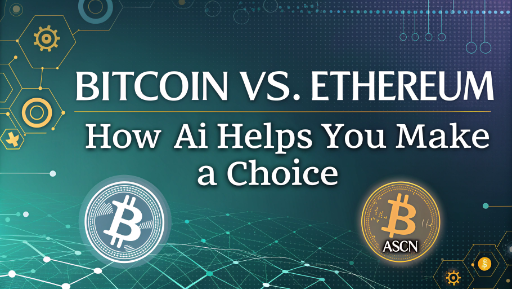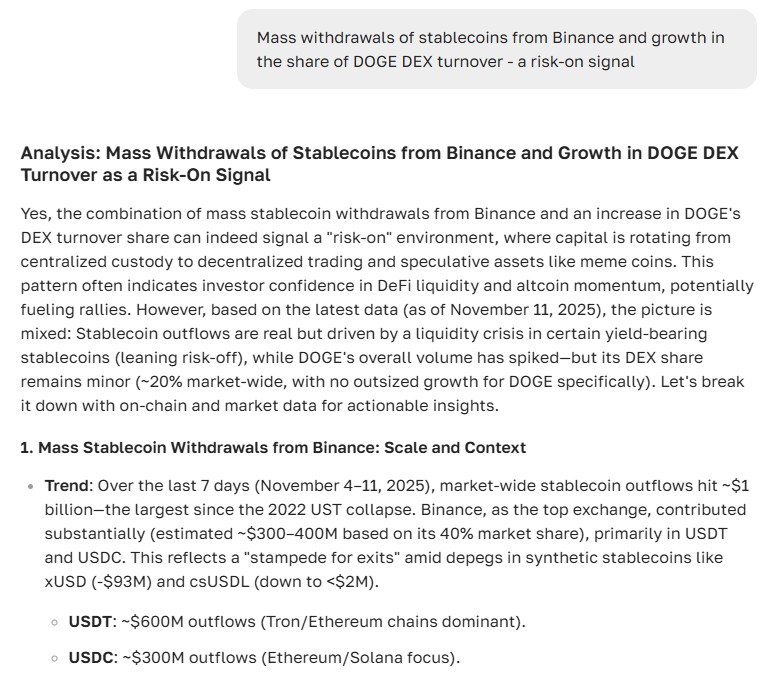Bitcoin vs. Ethereum: How AI Helps You Make a Choice - ASCN

Lining up Bitcoin and Ethereum side by side doesn’t really make sense. They were built for different purposes — and that means you need a different lens to understand each one. Instead of chasing general market moods, it’s smarter to look straight at on-chain data — that hard, emotion-free evidence written into the blockchains themselves.
That’s where artificial intelligence comes in. It cuts through the noise and reads the real network activity. So rather than arguing over which is “better,” let’s break down how each blockchain actually works, what metrics matter, and how to read the signals that come from the networks themselves.
Bitcoin: Digital Gold
Bitcoin is the crypto world’s version of gold — a hedge against inflation and the unpredictability of banks. Its power lies in being predictable and dependable.
The Core Idea: Store of Value
Bitcoin isn’t here to host dApps or games. It has one job — to hold value. Its supply is capped at 21 million coins, and decentralization keeps it safe from manipulation. When fiat currencies inflate or economies wobble, BTC stands as a safe haven.
The Tech: Proof-of-Work and Security
Bitcoin runs on Proof-of-Work. Miners solve cryptographic puzzles, securing the network through sheer computational effort. To attack it, you’d need 51% of the network’s power — technically possible, economically insane. The cost of electricity and hardware would crush any potential reward. It’s simply cheaper to play by the rules.
Of course, PoW has its downsides — it eats energy and doesn’t scale easily. But it was never meant to be a fast computing layer. It’s a shield, not a processor.
Key Use Case: Inflation Hedge
When central banks keep printing money and inflation spirals, Bitcoin’s limited supply becomes its strongest argument. Only 21 million will ever exist — a built-in deflationary feature.
Many investors see it as “monetary insurance.” It may not skyrocket daily, but in a portfolio, it plays the role of a stabilizer — the thing that keeps the rest from shaking apart.
Ethereum: The World’s Computer
If Bitcoin is the vault, Ethereum is the workshop. It’s where people build — apps, tokens, DAOs, and entire digital economies.
The Main Goal: A Platform for Apps (dApps)
Ethereum isn’t just a currency. It’s an ecosystem — smart contracts, DeFi, NFTs, GameFi. In simple terms: if Bitcoin stores value, Ethereum fuels it. Think of ETH as the operating system of Web3.
The Tech: Proof-of-Stake and Smart Contracts
Ethereum made the big switch from PoW to Proof-of-Stake. Validators now lock their ETH to secure the network and earn rewards. It’s greener and more flexible, though arguably more vulnerable — a 51% attack here could come from someone staking massive amounts of ETH, not raw computing power.
Smart contracts are the beating heart of it all — bits of code that execute automatically when conditions are met. Every DeFi loan, NFT marketplace, and DAO runs on them.
For example, when you take out a crypto-backed loan, the smart contract locks your collateral. Once the loan is paid off, it releases it — no middleman, no bank manager, just code.
Key Use Cases: DeFi, NFT, GameFi
Ethereum is the backbone of decentralized finance — lending, liquidity pools, stablecoins. Most NFTs are minted here too. And GameFi — blockchain gaming economies — often run on Ethereum or its Layer 2 networks.
The Real Challenge: Different Assets, Different Logic
People love to compare Bitcoin and Ethereum “head to head,” but that misses the point. They’re built for different jobs, and their data tells different stories. To understand either one, you need to speak the language of metrics, not emotion.

How to Read “Digital Gold” (BTC)
For Bitcoin, pay attention to:
-
Concentration levels: how many large holders, or “whales,” dominate the supply.
-
Exchange inflows/outflows: are traders buying or selling?
-
Holder behavior: how long coins sit untouched.
-
Institutional activity: funds, ETFs, and long-term accumulation trends.
How to Read the “Tech Company” (ETH)
Ethereum’s ecosystem requires a different set of lenses:
-
dApp activity, transactions, and TVL (Total Value Locked).
-
Developer pulse: code commits, active repositories, project growth.
-
Network data: fees, block times, congestion.
-
Layer 2 adoption: how quickly new scaling chains are expanding.
-
Capital flows: where money moves across DeFi protocols and bridges.
The Data Dilemma
Different metrics, different networks, different mechanics — and a sea of messy data sources. Comparing Bitcoin and Ethereum directly can be misleading. Between bots, fake transactions, and fragmented sources, it’s easy to draw the wrong conclusion. Without AI analysis, even experienced analysts get lost.
How ASCN.AI Reads Both Networks
That’s where ASCN.AI steps in. It’s an AI agent designed to “look into the blockchain,” analyzing flows, behavior, and signals — not headlines.
The “Gold” Side: Bitcoin Metrics
ASCN tracks large BTC movements between exchanges and wallets, spots when whales move coins into cold storage (a strong hold signal), and monitors distribution patterns to see whether ownership is getting more concentrated or diversified.
The “Platform” Side: Ethereum Metrics
For Ethereum, it digs into dApp usage, transaction counts, and protocol liquidity. It tracks TVL growth, new Layer 2 launches, and correlations between on-chain data and price action.
The Web3-AI Advantage
ASCN isn’t your average Web2 data scraper. It’s Web3-native — it understands tokens, wallets, consensus mechanisms, DeFi protocols. It speaks blockchain natively. Terms like Proof-of-Stake, staking, or capital flows aren’t just buzzwords; they’re variables in its models.

Data Over Opinion
ASCN works with facts: what wallets actually do, where money really goes, how ecosystems behave in real time. No hype, no emotion — just clean on-chain data that helps users make informed, level-headed decisions.
Data-Driven Comparison: What to Look At
There are dozens of ways to compare the two networks, but only a few metrics really reflect the heartbeat of each blockchain.
| Metric | Bitcoin / BTC | Ethereum / ETH |
| Active addresses / transactions | Daily address and transaction count | Same, plus dApp activity |
| Fees & network load | Average block fee | Gas costs, congestion |
| Developer activity (GitHub) | Core client updates | Massive repo ecosystem, L2 libraries |
| Institutional interest | BTC ETFs, custody funds | ETH ETFs, DeFi-focused funds |
| DeFi / TVL | Minimal | Major - billions locked in protocols |
| Capital flows | Exchange transfers | Deposits into protocols and bridges |
Tracking these alone already paints a clear picture of how healthy (or overheated) each network is.
Investment Thesis: What Do You Believe In?
At the end of the day, analysis leads to one question — where do you place your trust (and money)? Bitcoin and Ethereum embody two philosophies — stability vs. innovation. The right mix depends on your appetite for risk and your belief in the future.
The Bitcoin Case: Stability and Reliability
The original cryptocurrency that started it all.
-
Proven history, limited supply, institutional backing.
-
Less experimental, fewer bugs.
-
Acts as a “portfolio anchor” against high-volatility assets.
The Ethereum Case: Growth and Innovation
The network that powers most of today’s crypto world.
-
Constantly spawning new protocols, businesses, and ideas.
-
Expanding ecosystem (L2, DeFi, NFTs) with strong growth potential.
-
A driver of crypto’s technological evolution.
Balanced Portfolio View
You don’t have to choose sides. Many investors hold both — Bitcoin as the defensive piece, Ethereum as the growth play. The proportions depend on your risk profile, time horizon, and conviction.
The Road Ahead: Competition and Evolution
Both blockchains are still evolving — just in very different directions.
The Future of BTC: Layer 2 and Adoption
Even if it looks old-school next to newer chains, Bitcoin’s not done innovating:
-
Layer 2 solutions (like Lightning Network) are improving speed and lowering fees.
-
Payment adoption keeps rising — more institutions are adding BTC to their balance sheets.
-
Protocol upgrades could enhance privacy and efficiency down the line.
The Future of ETH: Scaling and Rivals
Ethereum isn’t the new kid anymore, but it’s still the heart of Web3:
-
Layer 2 growth (Optimism, Arbitrum) is easing congestion.
-
Competitors like Solana, Polkadot, and Avalanche are pushing it to evolve faster.
-
Ethereum 2.0, sharding, and better data availability are next on the roadmap.
Some speculate ETH might eventually overtake BTC in market cap — “the Flippening.” It’s possible, but for now, it’s just theory.
Final Thoughts
Bitcoin and Ethereum are the two pillars of crypto — each with its own mission, architecture, and rhythm. With ASCN.AI’s on-chain intelligence, you don’t just watch the price; you see the flows, the network activity, and the pulse of the entire ecosystem.
Before investing, ask yourself: do you believe in stability or innovation? Let data — not hype — guide your decision. And if you want to see how this works in action, just message the ASCN bot the word “case” — you’ll get a full conversation example showing how to ask smart questions and interpret the answers like a pro.
FAQ
Can Ethereum really surpass Bitcoin in market cap (the “Flippening”)?
In theory, yes — if Ethereum’s ecosystem grows fast enough to attract institutional money. But for now, BTC still wears the crown as “digital gold.”
Why are Ethereum gas fees so high?
Because the network gets crowded. Too many dApps, too many users. During demand spikes, people pay extra just to get included in a block. Layer 2 networks help ease that load.
Is Bitcoin’s technology outdated?
Not really. It’s deliberately conservative. PoW, limited supply, and a simple architecture exist for one reason — to make Bitcoin as secure and predictable as possible.
What are PoW and PoS algorithms?
They’re consensus mechanisms:
-
PoW: miners solve puzzles and expend energy to add blocks.
-
PoS: validators stake their tokens and earn the right to create new blocks — faster and greener.
Should investors pick one, or hold both?
Holding both BTC and ETH makes sense for most portfolios — Bitcoin as the stable hedge, Ethereum as the innovation bet.
Bitcoin vs. Ethereum: Сравнение и Анализ - ASCN.AI
Сравните Bitcoin и Ethereum не по мнениям, а по данным из сети. AI-аналитика для объективной оценки технологий и инвестиционных возможностей - ASCN.AI



